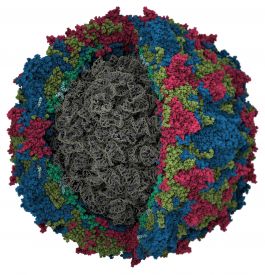Over 40 years ago, researchers were happy to have a War on Cancer. President Richard Nixon made it a national priority and it came with a lot of funding, so no one corrected what became an obvious point decades and billions of dollars later; you can't cure cancer.
Efforts at eradicating diseases may be doomed because of a mismatch between the ways humans structure the world and the ways pathogens move through the world, according to a paper in The Lancet Infectious Diseases. Polio is the poster child for diseases science has successfully conquered but the deadline for its eradication came and went in 2013 and is now 2018. What is going to change by then?

Computer-generated model of a poliovirus: Genetic material is tucked inside a protective protein shell. Credit: University of Arizona
Probably not much. In 1988, the 41st World Health Assembly adopted a resolution for the worldwide eradication of polio and 25 years seemed a long way off. They created the Global Polio Eradication Initiative but rather than being eradicated, it has resurfaced, and now it brings with it violent acts against health workers in places Pakistan and Nigeria, where rumors are that the polio vaccine is part of a Western plot.
Unlike smallpox, poliomyelitis – a debilitating disease affecting the nervous system and causing permanent paralysis – has never been completely eradicated. According to the authors, one of the biggest challenges in ridding the world of polio is a mismatch in the way humans perceive and structure the world and the ways viruses – and, by extension, other pathogens – move through the world.
"The ways we believe the world is structured clash with the structure of the world that is relevant to the virus," explained co-author Del Casino, professor of geography at the University of Arizona. "If we were to scale down our focus from the world of humans to the world of viruses, we'd end up in a different place in how we imagine the world and we'd start to think differently. Polioviruses don't need or rely on our view of the world. Their existence is based on human bodies and how to move from one to the next."
"In our society, we have a tendency to make sense of the world by organizing it into boxes," said Georgia Davis, a doctoral candidate in the School of Geography and Development. "We think certain pathogens occur here, but not there, and they get from this host to that host, and this is how they do it. But in reality, our attempt to understand the world by ordering it in certain ways may actually preclude us from really understanding it."
"Put another way," the authors write, "polioviruses maintain themselves by seeping through the boundaries – real or imagined – we use to contain them. In view of this, we need a more cautious approach to our thinking, and might need to reduce our expectations of global eradication efforts."
With Lyme, for instance, reporting happens on a county level, Davis said. On some maps, it appears that Lyme is endemic in one county but almost nonexistent just across the county border.
"It's the same for dengue fever," said Melinda Butterworth, also a doctoral candidate in the School of Geography and Development, who researches the mosquito-borne disease. "We're seeing a global resurgence of the virus, including several recent outbreaks in the U.S. Yet dengue is mostly thought of as a 'tropical disease,' so the diagnosis isn't always made."
"The issue of accurate testing and reporting of infectious diseases is a classic concern in health and medical science," Butterworth added. "But it matters for geography too, because it influences what our maps of disease distributions look like. Those maps influence how we understand where diseases are, and how we test for and monitor their spread."
The picture gets even more complicated in light of conflicts between people or entire nations, climate change and health care disparities.
"Climate and environmental changes alter the habitats of pathogens and vectors in ways we're still trying to understand," Butterworth said.
"Let's say a particular nation has vaccination programs, but a neighboring country doesn't, and yet another has them but can’t enforce them uniformly," Davis explained. "Add migration to the mix and you can see how this creates holes for pathogens to move through and escape our ability to map them, let alone eradicate them."
The number of new polio cases has dropped dramatically, from 716 in 2011 to 223 in 2013, but more cases are cropping up.
"What is interesting is that, since 2013, which saw tensions in Somalia, the crisis in Syria, and a deteriorating situation in Afghanistan, there has been a creeping increase in cases," Del Casino said. "There almost was a chance to contain the virus, but it has become very difficult to contain those spaces, because viruses move faster than that."
Citation: Vincent J Del Casino, Melinda Butterworth, Georgia Davis, 'The slippery geographies of polio', The Lancet Infectious Diseases, Volume 14, Issue 7, Pages 546 - 547, July 2014 doi:10.1016/S1473-3099(14)70802-3





Comments